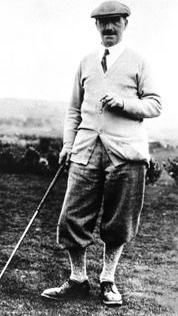Alister MackenZie
“A good golf course grows on one like a good painting, good music, or any other artistic creation. It is not necessarily a course which appeals the first time one plays over it, but one that grows on the player the more frequently he visits it.”
< BACK
Influential in the design of Bingley St. Ives Golf Course back in the 1930s and his signature style is still in evidence today.
Born on 30th August 1870 in Normanton, Yorkshire. A Cambridge graduate, he went on to practice medicine in Leeds before travelling to South Africa to serve as a Civilian Surgeon for the British Army Somerset Regiment during the Boer War. It was in these trenches that MacKenzie became interested in camouflage, and this went on to inspire his golf course designs.
MacKenzie had been a member of several golf clubs in and around Leeds, dating back to the mid 1890’s. His career in golf architecture finally got off the mark in 1905, when he formed a partnership with Harry Colt. Such a partnership proved fruitful as by 1909, an opportunity arose to build a new course at Alwoodley near Leeds. MacKenzie presented the club with a series of designs for the course. He also called on the skills of Harry Colt to settle disputes on the layout, but Colt agreed on much of the design and left MacKenzie to complete the work.
The Colt / MacKenzie partnership lasted 18 years, with MacKenzie’s departure in 1923. Such an exit from the partnership was most likely fuelled by a long lasting tension between the two architects. At the time he designed Bingley St Ives he was working with Bobby Jones and our course is one of the few courses in the UK to be credited with a Mackenzie/Jones design (www.golfadvisor.com) .
MacKenzie’s design styles were a knee jerk to convention and bucked traditional trends. His bunkers would defy the pot bunker norm. They would be large flourishes of sand with their size depicting their importance and their position warning the player quite clearly of the penalty awaiting a crooked or misplaced shot. Such were his bunkers that it can be argued that MacKenzie created the greatest bunkers the game has ever seen.
His holes were designed for strategic play, with many of them angled away from the line of the fairway. This forced golfers to consider the green approach shot right from the tee. In 1926, MacKenzie travelled to Australia to advise improvement for the West Course at Royal Melbourne. During what was a surprisingly short stay, MacKenzie designed or redesigned several other courses including Kington Heath, Metropolitan, Yarra Yarra, Victoria and New South Wales. However, it is Royal Melbourne that remains most notable today.
By 1931, MacKenzie had designed 41 original courses, plus 14 with partners. He had become one of the most influential golf course architects of that era, most of it being works outside Europe following his permanent move to the United States in the 1920’s. From then on, much of his work was concentrated to Australia and North America.
It was his inspirational work in Australia that led to his commission at Cypress Pointe in the United States and his later work at Augusta National in 1929. Of his work in the United states, both of these courses and Crystal Downs receive the most accolade – although it is the latter that it is argued that much of the work was carried out by another architect, Perry Maxwell.
The 16th and 17th at Cypress Pointe, designed in 1928, demonstrates an excellent example of MacKenzie’s fascinating routing choices and challenges that so few architects would dare try. Before arriving at these two holes, players are gently taken from dunes to the forest, back to the dunes and finally to the ocean. At such point, The player is confronted with a leap of faith between two rocks on both occasions, with the gap between being a massive drop to the sea below. In fact his sheer disappointment at the lack of controversy at Cypress Pointe is understandable as the course remains one of the most prestigious and challenging courses in the world.
Augusta, designed in 1929, was one of MacKenzie’s last notable offering to the world of golf before his death in 1934 on the year of the first Masters. The course has been altered many times since then, but understandably so, as technological advances in equipment and skills in modern day players demands the need for increasingly difficult challenges.
For more information about the work of Dr. Alister MacKenzie, visit the website ALISTER MACKENZIE SOCIETY




